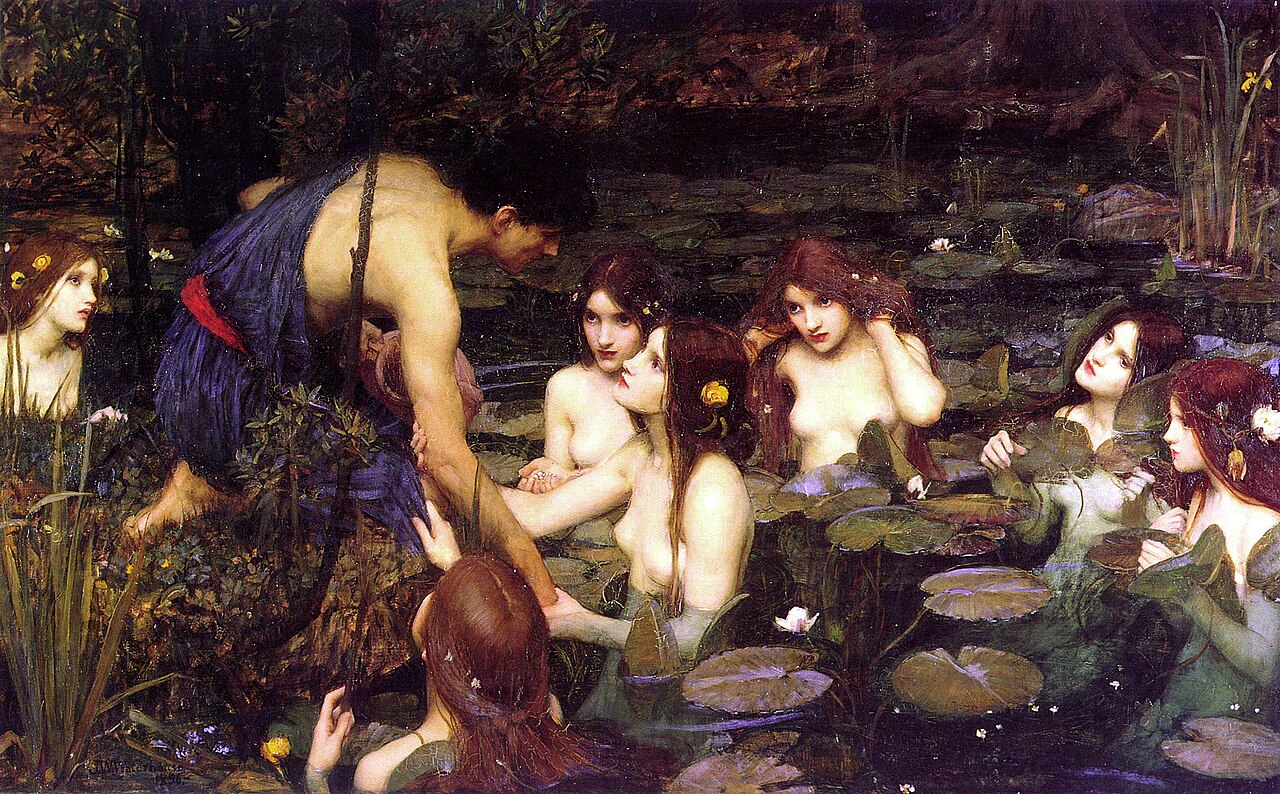Nymphs
The nymphs weren’t mere observers of nature; they were its very essence come alive. These enchanting spirits, dwelling in forests, rivers, springs, meadows, mountains, and seas, were the unseen crafters of its wild beauty. From the delicate bloom of wildflowers to the towering strength of ancient trees, the nymphs nurtured all living things. With their touch, they coaxed forth gurgling springs, babbling brooks, and serene wetlands, weaving a tapestry of life across the land.

The nymphs’ connection to the gods wasn’t singular. Some, like the wild Maenads and Bacchae, served as companions to Dionysus in his revelry. Artemis, the huntress goddess, found solace in her band of nymph companions, their skills as keen as her own. Hecate, mistress of the crossroads and magic, was attended by the shadowy Lampades, their loyalty unwavering in the depths of the underworld. Nereids, daughters of the sea, formed Poseidon’s court, while Olympian goddesses enjoyed the service of devoted nymph handmaidens.
Beyond their captivating beauty, some nymphs played a vital role in the upbringing of the gods themselves. The Idaean nymphs of Mount Ida served as foster mothers to the infant Zeus, cradling him and ensuring his safety during his most vulnerable years. Similarly, the Nysian nymphs played a crucial part in raising Dionysus, nurturing him through his childhood and helping him develop into the powerful god of wine and revelry.

There were many different types of nymphs that populated the Greek world. Each type had its own unique character and association, reflecting the diverse aspects of nature they embodied:
Aurae:
- Domain: These nymphs were the personification of gentle breezes and refreshing air. They were not necessarily tied to one specific location, but rather roamed freely, carrying whispers on the wind and ushering in pleasant weather.
- Appearance: Aurae were often depicted as young women with flowing robes and wings, sometimes carrying flowers or fruits that symbolized the season’s bounty.
- Significance: They were associated with both positive and negative aspects of the wind, bringing refreshing breezes and clear skies but also storms and whirlwinds.

Bacchae and Maenads:
- Domain: These terms are often used interchangeably and refer to the female followers of the god Dionysus, the god of wine, revelry, and religious ecstasy. They were not immortal beings but mortal women who participated in his ecstatic religious rites.
- Appearance: Bacchae and Maenads were depicted in various ways, sometimes wearing animal skins and carrying thyrsi (staffs topped with pine cones) or instruments associated with Dionysus’ worship. In their ecstatic state, they might appear disheveled and wild-eyed.
- Significance: Bacchae and Maenads were known for their frenzied dances, emotional abandon, and connection to the raw power of nature. Their participation in Dionysian rituals challenged social norms and explored themes of liberation, intoxication, and the divine madness associated with the god.

Dryads:
- Domain: These nymphs were the spirits of trees, specifically those bound to a single tree for their entire lifespans. They were fiercely protective of their wooded homes and the creatures that dwelled within.
- Appearance: Dryads were often depicted as young women with their hair adorned with leaves and flowers, their skin resembling the bark of their tree.
- Significance: Dryads were seen as vital to the health and well-being of the forest. harming a dryad could mean harming the tree itself, and some myths portrayed them as vengeful if their domain was threatened.

Hesperides:
- Domain: These nymphs were the guardians of a mythical garden in the west, where a golden apple tree (sometimes depicted as multiple trees) produced fruit that granted immortality or eternal youth.
- Appearance: The Hesperides were often depicted as beautiful maidens, sometimes with wings.
- Significance: Their role as guardians and the allure of the golden apples made the Garden of the Hesperides a frequent target in myths, most notably in the labors of Heracles.

Lampades:
- Domain: These mysterious figures were attendants to the goddess Hecate, goddess of crossroads, magic, and the underworld. They were not strictly nymphs, but rather spirits associated with the underworld and the night.
- Appearance: Lampades were depicted as young women carrying torches, their flames casting an eerie glow. Some descriptions mention them as having snake-like legs or other monstrous features.
- Significance: Their torches illuminated Hecate’s path during her nocturnal travels and symbolized the ability to see through darkness, both literally and metaphorically. They were associated with the secrets of the underworld and the power of magic.
Naiads:
- Domain: These nymphs were the spirits of freshwater sources – springs, fountains, streams, and lakes. They were known for their playful and carefree nature, often associated with dancing, singing, and laughter.
- Appearance: Naiads were depicted as young women with vibrant skin and flowing hair, often adorned with freshwater pearls, lilies, or reeds.
- Significance: Naiads were seen as the source of freshwater, crucial for both life and agriculture. They were also associated with fertility and purity.

Nereids:
- Domain: These nymphs were the fifty daughters of the sea god Nereus and the sea nymph Doris. They dwelled in the ocean depths and were associated with its beauty and power.
- Appearance: Nereids were depicted as beautiful maidens with long, flowing hair and fishtails, often depicted riding dolphins or seahorses.
- Significance: They were companions to Poseidon and other sea gods, and played a role in calming or stirring the seas with their dances. Some myths depict them assisting sailors or luring them to their deaths.

Oceanids:
- Domain: These nymphs were the three thousand daughters of the primal Titans Oceanus and Tethys, representing all the freshwater sources that flowed into the ocean and the concept of the vast ocean itself.
- Appearance: Oceanids were depicted as beautiful maidens with flowing robes, sometimes carrying water urns or other symbols of their watery domain.
- Significance: They were associated with the vastness and power of the ocean and were seen as the source of all freshwater on earth. They also played a role in myths alongside other water deities.

